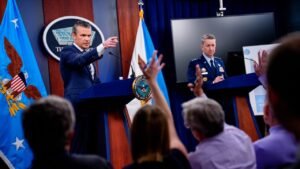During the Iran strike, Hegseth and Caine assume opposing roles as crucial architects. On Sunday morning,

Defence Secretary Pete Hegseth and Chairman of the Joint Chiefs of Staff Dan Caine addressed a pair of lecterns in the Pentagon briefing room to provide a comprehensive account of the most significant military operation of President Donald Trump’s presidency.
was the first to speak, and he lavished praise and congratulations on his employer in a moment that was tailor-made for television. He wore a pressed American flag pocket square in his lapel. The Iranian nuclear program was “devastated” and the Fordow nuclear site’s capabilities were “destroyed” by Operation Midnight Hammer, which he characterised as a “overwhelming success.”
The moment emphasised the fundamental distinction between the two men and their opposing strategies as Trump’s senior military officials. Trump, a master of stagecraft, has long emphasised the significance of having senior officials who are directly recruited from “central casting.”
, a former Fox News anchor, has been a visible presence as the president deliberated US involvement. This opportunity arose after his initial months in the position were tainted by the Signal group chat scandal and internal turmoil among his staff. Concurrently, Caine has emerged as a discreet yet reliable advisor who operates in the background.
And as Trump contemplated the most significant decision of his presidency, it was the qualities that Caine exhibited on Sunday that he cherished behind closed doors. A core group is formed in anticipation of the attack. Caine was one of a select group of aides that Trump came to rely on as he was presented with military options to target Iran’s nuclear program.
As well as CIA Director John Ratcliffe and special envoy to the Middle East Steve Witkoff, Gen. Michael Kurilla, the chief of US Central Command, was a significant voice for Trump on the matter. Witkoff had been leading negotiations on a potential nuclear agreement that ultimately failed. In recent months, Hegseth was primarily deferential to Kurilla,
according to current and former officials, despite his personal scepticism regarding the expansion of US military involvement overseas. Kurilla’s influence over Hegseth was frequently a source of disagreement among the more non-interventionist members of the Pentagon chief’s inner circle during a US military operation against the Houthis in Yemen earlier this year.
During a CNN interview, one of these members claimed that Kurilla would “run circles around” Hegseth. US Central Command, which is accountable for American military operations in the Middle East, has also expressed a more urgent sense of urgency than the civilian intelligence community regarding Iran’s pursuit of a nuclear weapon.
Trump’s Iran strike is a significant victory for Netanyahu; however, the outcome remains uncertain. A source familiar with the discussions has stated that Central Command had endorsed a more dire timeline in the lead-up to Israel’s attacks on Iran earlier this month.
The command believed that Tehran could obtain a usable nuclear weapon more rapidly if it were to sprint towards that goal. Trump relied on Caine and Kurilla, despite the fact that Hegseth has been present at national security meetings at the White House regarding Iran and at a meeting at Camp David where senior officials devised potential US involvement options.
Leave a Reply